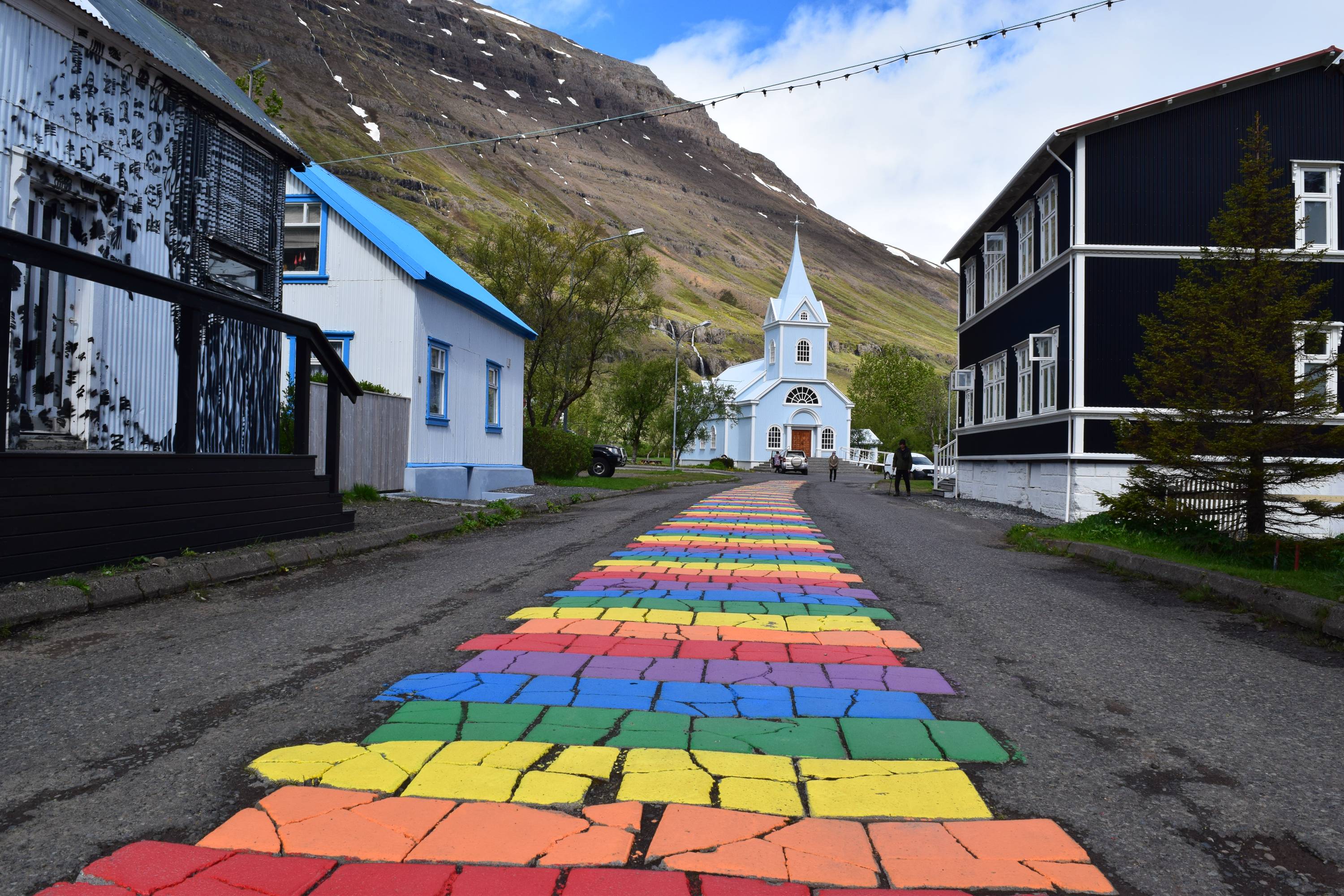When you travel through the Land of Fire and Ice, you’ll find green and lush valleys with hot springs and majestic glaciers in the background. There is another part of Iceland, though, that better depicts the creation of the island and what happens when the volcanic forces don’t entirely retreat. Námaskarð is one of those places.
At Námaskarð, you’ll witness, in person, what happens when Mother Nature doesn’t leave room for life to take hold. Here, you’ll come face to face with the chemical and thermal effects that lure many to the island. Read on to delve deeper into this phenomenon in our article about Námaskarð!
Námaskarð in Short
If you want to visit one of the hottest spots in Iceland, you need to drive by Námaskarð. This is literally one of the areas in Iceland with the highest temperatures (excluding the actively erupting volcanos), and it has a massive collection of cool geothermal features. The Námaskarð Geothermal Area is best known for its power production, colorful landscape, and eggy smell.
Geothermal areas like Námaskarð are formed by the heat coming from the volcanic activity deep underground. Námaskarð's vibrant geothermal activity is a direct result of Iceland's unique geological setting. Positioned atop the Mid-Atlantic Ridge, where the Eurasian and North American tectonic plates diverge, Iceland experiences intense volcanic and geothermal activity.
The fumaroles, for example, are best described as ventilation shafts for the crust of the Earth. They ventilate fumes and steam, which gives rise to the massive steam clouds that envelop the site. Luckily, it’s mostly steam coming up, so you don’t have to worry about walking in and out of the steam clouds on site. Just don’t stand in them for hours on end, and you’ll be fine.

Another geothermal feature is the mud pools. These peculiar things are created when water underground gets mixed with acidic compounds (often sulfur) and gets forced through cracks in the ground while it’s boiling. This mix of acid and heat breaks down the surrounding rock, creating the bubbling mud pools we see at Námaskarð today.
Despite this violent activity underneath, Námaskarð in Iceland is a safe place to visit, as long as you keep within the marked-out walking trail. Parts of the ground can reach up to 200 degrees Celsius and can cause some serious harm if you don’t adhere to safety regulations. Luckily, the entire area is clearly marked and even has wooden platforms that allow you to get closer to the bubbling mud pools and fumaroles.
The History of Námaskarð
Námaskarð is part of the Krafla Volcanic System, which has a very active history. The latest eruptions took place between 1975 and 1984 and are locally known as the Krafla Fires. During this time, there were 9 separate eruptions and a total of 15 incidents of the ground either collapsing or being lifted up.
Before that, the only major event that caused significant destruction was the Mývatn Fires between 1724 and 1729. Massive cracks in the ground opened up, and fountains of lava spewed out. These fountains were so high that they could be spotted from the southern part of Iceland and caused serious harm to the nearby farms and settlements. All in all, it was a terrible time to be a farmer in the Mývatn area.
When the ground is not exploding and/or laying waste to nearby farms, Námaskarð has been a prosperous area for the entrepreneurial with little regard for one’s health. Sulfur mining is a hazardous job and has been an important part of the history of Námaskarð. There was a time when half of all the sulfur used in Europe was supplied from this area, and most of the gunpowder production in the late Middle Ages was dependent on the Icelanders mining sulfur at Namaskard.

The Geology and Geography of Námaskarð
Námaskarð is actually the name of a mountain pass between Námafjall and Dalfjall and has all the characteristics of a volcanically active environment. The constant bombardment of acidic fumes has made the ground completely sterile, and the landscape has a distinct desolate look. The sides of Námafjall and Dalfjall are both as sterile as Námaskarð, and you can see a rainbow of colors along the mountainsides.
The different colors in the area come from the mineral variation in the Rhyolite and the crystal deposits left behind from the volcanic fumes and mud pools. The mineral variation can be seen along the sides of the mountains and in areas far away from the fumaroles and mud pools. Crystals can more often than not be seen along the rims of mud pools and fumaroles, as well as along the edges of small streams of highly acidic water. This is the last place you want to refill your water bottle.
It's worth noting that all of them are cool to look at, but we strongly recommend you leave them where they are. They might look harmless, but they can hurt you in worse ways than the fumes smell.
The different colors at Námaskarð come from different chemicals compounds:
- Red and brown (the most common) often come from iron oxide compounds. It’s basically rust, but at Námaskarð, it’s also acidic.
- Yellow and orange areas are often very rich in sulfur that should be seen and not touched. This stuff will burn like a freshly cooked pizza, but without any good stuff and nothing but an expensive hospital bill.
- All light colors, like grey, light blue, light pink, and so on, are compounds that are rich in silica and calcium. You’ll often find these colors around the mud pools.

Power Production at Námaskarð
When it comes to harnessing nature, Icelanders are the masters of geothermal energy. The volcanic system that Námaskarð is a part of has massive potential, which is evident when we look at the Krafla Power Station. It is located just west of the Námaskarð Pass and is the main supplier of energy in the region.
The way this works is that geothermal areas like the Namaskard Pass have a lot of superheated water under a lot of pressure deep in the Earth’s crust. Steam turbines are connected to these water sources through pipes and generate power as the high-pressure steam causes the turbines to spin at incredible speeds.
Where is Námaskarð?
You find Námaskarð in Northern Iceland, roughly 5 kilometers east of Lake Mývatn. This is one of the best areas to visit on a trip around the Ring Road since it is very close to the road and doesn’t take a lot of time to visit. It’s also right on the Diamond Circle, so you know you can pair it with some pretty cool attractions in Northern Iceland.
How to Get to Námaskarð
Since Namaskard Geothermal Area is right on the Ring Road, getting there is as easy as pie. The only drawback is that it takes a long time to reach it if you drive from the capital.
You can visit Námaskarð either by driving yourself or joining a tour.
Drive Yourself
We will always encourage people to drive around Iceland on their own to explore the country on their own terms. To get to Námaskarð from Reykjavik, all you have to do is get on the Ring Road and drive in any direction until you get there.
The shortest way to get to Námaskarð from Reykjavik is to head north on the Ring Road and continue for about 470 kilometers. That will take you about 6 hours if you don’t stop along the way, but since there are plenty of cool things to see along the way, we strongly recommend making this into a multi-day trip.
Join a Tour
There are many types of tours you can take that will allow you to enjoy the eggy atmosphere at Námaskarð. The most common ones are:
- Multi-day tours around Iceland.
- Multi-day tours around the Diamond Circle.
- Day tours around Lake Mývatn.
If you take one of the tours from the capital, you can sit back and enjoy many of the attractions around the country. The tours around the Diamond Circle will take you through the gems of Northern Iceland, and the Mývatn tours will concentrate on what is happening around the lake.
Each will provide a unique experience, so the only important thing for you is to choose which one suits you best so you can get the most out of your trip.
What to Do Near Námaskarð
Even though we love to spend a lot of time at Námaskarð (despite the smell), there are many things nearby that are also worth your attention:
- Grótagja Cave – the famous cave from Game of Thrones.
- Skútustaðagígar Pseudo Craters – amazing geological formations at Lake Mývatn.
- Krafla Volcano – the main culprit of the Krafla Volcanic System.
- Viti Crater – a massive crater with a stunning lake in it.
- Hverfjall Crater – a massive and symmetrical crater with a nice hiking trail.
- Dettifoss Waterfall – the most powerful waterfall in Iceland.
- Dimmuborgir Lava Field – simply an otherworldly experience.

Plan Your Drive to Námaskarð
Visiting Námaskarð is guaranteed to make memories of a lifetime, and the area is a perfect depiction of how powerful nature can be. The mud pools and fumaroles are not things most of us see every day, so you must grab the opportunity when it presents itself. Iceland is riddled with these attractions, and you should visit as many of them as you can during your Iceland holiday.
The best way to see as much of Iceland as possible is to rent a car in Iceland and take charge of your adventure. The freedom to explore is key to a successful holiday, and the only things you’ll need to worry about when deciding to go road-tripping are which route to take, what places to visit, and how much storage you’re gonna need for all those photos of unforgettable moments, such as Namaskard, along the way. So, enjoy, and we wish you all safe travels!


 By
By


